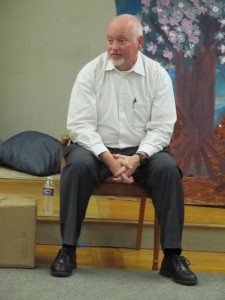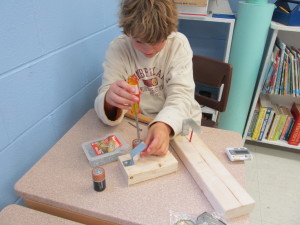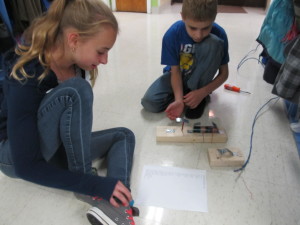
Last year the teachers began a long term project that integrated science, technology, social studies and language arts. As teachers we began by jointly reading an inspiring book called The Boy Who Harnessed the Wind. We were able to ascertain that a young people’s version of the book would be issued in February 2015.
Once we knew we could bring an accessible version of this very moving story to our students, we began to plan a series of activities that would allow our students to recapitulate the processes and learning of the hero of the book, William Kamkwambe.
We began with several strands. One strand was giving our students a chance to take apart appliances. As they took them apart, they drew the outside of the machine and tried to predict how it looked and worked on the inside. They drew one part that interested them and thought about how it could be used in another machine. In the end they drew an invention of a new machine, using at least one of the parts from their take apart machine.
They also made a take apart museum and used a check list to see which parts seemed to present in all or many of the machines
A second strand was two different science classes on electromagnetism. It was generally split into older and younger students. Younger students explored static electricity, electric circuits, made question and answer boards. Older students explored making and redirecting a compass with the effects of electromagnetism, making an electromagnet, investigating the creation of magnetic fields and electrical fields and the relationships between them—a moving magnetic field creates an electric current and a moving electric current creates a magnetic field.
In February we read older and younger versions of The Boy Who Harnessed the Wind.
It was a wonderful opportunity to look at a way of life that is so different from our own: an absence of technology, a place of famine and drought, but also a place of family and friends. It was inspiring to read about William and realize he had never had electricity, flown in a plane, been in a hotel, seen a TV or a computer and yet he could teach himself, from textbooks in a language he could barely speak, how to make a better place in his own world. It was inspiring to see how he returned to his village, after finishing an American college, to make “small” changes” that made so much difference in his community.
This year we took the opportunity to work with Buzzy Dale and continue our investigation of electromagnetism. The older students made a telegraph and looked at the transformation of energy.
We were able to have a wonderful Mystery Guest to go with this unit. John Litteer, the NYS Traffic Signal Controller, came to school with a model of an induction coil. When we pull up to many traffic lights we all experience the effects of electromagnetism. Under the road is a 6’x6’ square of wire that interacts with the metal in our cars. As the magnetic field interacts with the car’s metal it triggers a computer on the side of the road to change the light to green. (No, we can’t really change the light by blowing or clapping). These systems have been in effect since the 1950s and are of apart of our daily interaction with electromagnetism.
 The class made a simple motor and looked at the relationship of the number of coils and strength of the current, how a magnet effects the direction of the current. We ended the unit by winding our own coil and constructing a generator that produced several amps of electricity and lit a tiny light bulb when a “wind”/fan blew our windmill. The turning windmill, like William Kamkwambe’s windmill, generated electricity. It was tricky trying to get the “wind” to blow our propellers. But at the last minute, it did…
The class made a simple motor and looked at the relationship of the number of coils and strength of the current, how a magnet effects the direction of the current. We ended the unit by winding our own coil and constructing a generator that produced several amps of electricity and lit a tiny light bulb when a “wind”/fan blew our windmill. The turning windmill, like William Kamkwambe’s windmill, generated electricity. It was tricky trying to get the “wind” to blow our propellers. But at the last minute, it did…
These students were also able to attend a field trip to Applied Concepts in Tully, a company that designs and manufactures various types of circuit boards. The students were given a tour of the manufacturing warehouse where they were able to see the production of one piece of a circuit board from start to finish. The final product will be used in LED screens on airplanes. The manufacturers were delighted that the students were able to identify many of the parts in the warehouse as well as explain what they were used for! The owner and lead electrical engineer invited the students into the conference room where he answered their questions and explained the business aspects of owning an engineering company as well as what education the students would need to enter the electrical engineering field.

